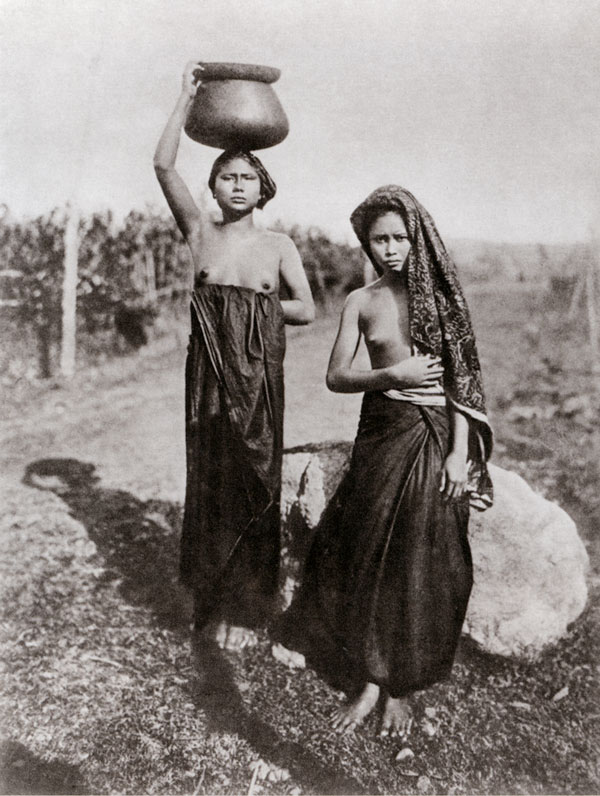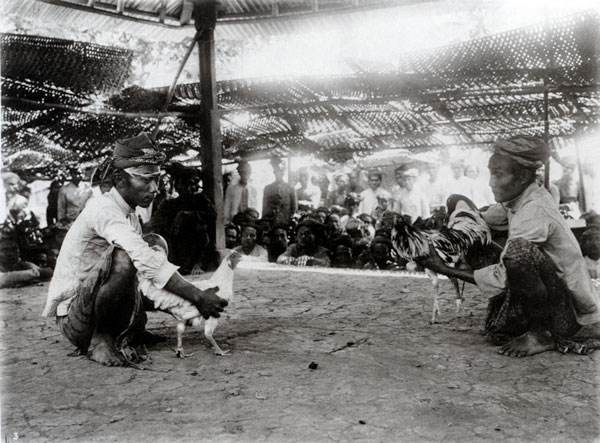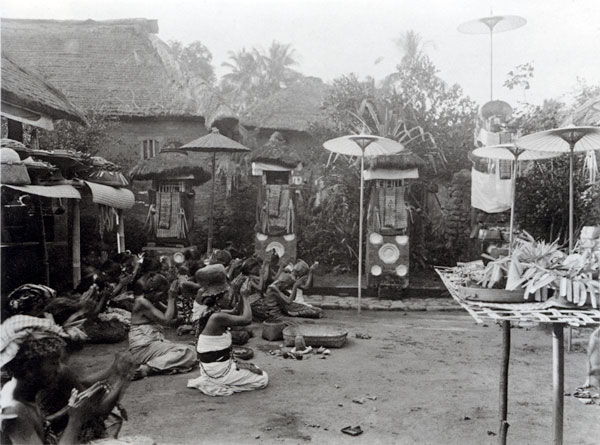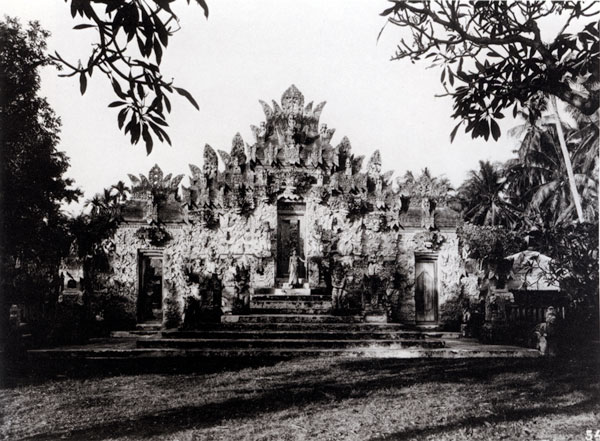 |
Thilly Weissenborn
Balinese women carrying water, c 1922. Photogravue |
If nineteenth and early twentieth-century male photographers established a way of showing the Dutch East Indies in the light of a benevolent colonialism bent on preserving quaint cultures and establishing an imperial sense of space, Thilly Weissenborn, the first major female photographer of the Indies, introduced a fundamental transformation in European ways of seeing the region.
Through her photography, she infused the earlier vision with a sense of the romance of the islands—the Indies as wish fulfillment. This warm, extroverted woman of dry humor and ready ability to make friends was more of a child of the Indies than she was Dutch.1 She was born in 1889 in Kediri, East Java, of German-born, naturalized Dutch parents who owned a coffee plantation there, and later in Tanganyika. She spent less time in the early part of her life in the Netherlands than in Java.
The beginning of Weissenborn's photographic career is something of a mystery. One elder sister, Else, had studied photography in Paris and set up a studio in the Hague by the time Thilly was fourteen, and we know that the younger sister was working in the Kurkdjian studio in Surabaya in 1917. However, a number of Kurkdjian photographs later attributed to Weissenborn appear in H. H. Kol's momentous 1914 exposition of Bali, Sumatra and Java.2 Most of the photographs in this book lack the warmth and glowing light of Weissenborn's later work in Bali; the poses of the men and women are particularly lacking the grace she brought to such images.
For example, the image of two men beginning a cockfight is very stiff, the participants and surrounding gamblers are frozen, waiting for instrucrions from behind the camera lens. The man on the left, with a feather of a defeated cock under his hat for good luck, glances away from the supposed focus of masculine attention—the matching of cock against cock before one meets his death.
Weissenborn was trained by the Kurkdjian studio after the death of its Armenian founder. She worked under the supervision of the skilled English craftsman, G. P. Lewis,3 and her apprenticeship included touching up photographs and a fulll range of technical work. The studio had thirty employees, European and native, and she was one of only two women.4 In 1917, when she moved to Garut, in the nest of hill stations of West Java, she set up her own studio, "Lux." It was originally a part of a pharmacy owned by Denis G. Bulder, but she moved it to a separate location in 1920.
From that time onward, Weissenborn began to mark her work with a special lyrical quality. The views of her base at Garut all display the cool misty air of the quiet hills to which the overdressed and proper Dutch escaped from the sultry coast. The formality of the Governor-General's palace at nearby Bogor, the tenderness of European mothers with their children and the uncertain spontaneity of colonial tennis parties provided her bread and butter at the time. More heart went into her long vistas of the hills and the scenes of mountain village life as a rural idyll. In these, she portrayed single native figures in the fore or middle-ground of scenes that stretch out from comfortable Dutch gardens to distant volcanoes. In such views, she was seeking the magical qualities of the landscape, a special communion with nature that was different from what Europe had to offer.
In the early 1920s, Weissenborn brought the romantic qualities she had developed in Garut to bear on the mountains, temples, women and princes of the island of Bali. She became most famous for this work, which was produced for a new tourist industry the Dutch wished to establish. From this time onward, a range of magazines, books and pamphlets were put out by tourist authorities and travel writers. These were designed to attract travelers to the East Indies by showing the exotic cultures of the islands tamed by colonialism, which in turn saw itself as preserving lavish indigenous cultures from the depredations of the modern world.
Although originally not considered important in the plans for tourism, Bali grew to be one of the keystones of that industry, and Weissenborn's photographs helped to give it that special aura by presenting its culture in the most exotic terms. In her Bali photographs, the tamed nature she captured in the hill stations of Java becomes one with the rich ornamentation of a temple gate, or blends into a sacred bathing place. A different kind of communion with nature, one centered around these lush temples and their art, made Balinese spirituality the epitome of the tropical East.
To combine nature and culture, Weissenborn frames her images of the baroque temple at Sangsit with frangipani branches, seeking similarities between the leaves of the ornamental silhouette and those of the tree. In a scene of an inner temple, she combines bright backlighting with the whiteness of ritual umbrellas and the holy gesture of prayer led by the Brahman high priest. The gestures of the assembled congregation move the observet's gaze upward to the sky as much as to the shrine, and they help to reinforce the clear break in the two halves of the composition.
The seated humans emerge out of the shadows of the platforms and coverings at the extreme left, while on the other side the whiteness is reinforced by the plates on the middle shrines, the cloth around the shrine to which worship is directed and the offerings set on a raised platform in the foreground. The shapes of the plaited leaves of the offerings are similar to those of the palm and pandus leaves in the background, giving a strong sense of the naturalness of Balinese religion, despite its strange and culturally rich qualities.
The ideal spirituality presented in this photograph is also present in Weissenborn's romantic images of Balinese men and women. Unlike many of the male photographers of Bali in the 1920s and 1930s, she avoided the prurience given to images of Bali's bare-breasted women and was concerned with showing the women's dignity and self-possession. In her image of two women along a roadside, this dignity comes through in the erectness of the woman carrying the pot on her head, a stance emphasized by her thin, straight sarong and sash, the downward, half-embarrassed movement of the second woman and the line of the tree to one side.
Ironically, these same images were easily appropriared into the general idea of Bali as the Island of Bare Breasts, the title of a French novel of the time. Given the abundance of images of semi-naked Balinese women produced from the 1920s on, it is not surprising that Weissenborn was unable to change substantially the masculine bias of this generalized image, but she had a far greater impact with her best-known photograph, that of a young dancing girl seated before a gong. This photograph was frequently reproduced in 1920s Dutch tourist literature and has subsequently been in the literature that continues to flood out about Bali.5 It captures that mysterious, ineffable quality of Bali—the inscrutable oriental culture of the island, rich but not threatening, that made it a place to which Europeans could escape from the drabness of their home.
Weissenborn's photograph of Gusti Bagus Jlantik, the intellectually able, short but handsome "self ruler" of the eastern Balinese state of Karangasem, captures her deep passion for understanding the inner spiritual qualities of the Indies through its exemplary characters. He was the Balinese ruler most favored by the Dutch, but also part of the new development of elite Indonesian self-assertion.
One of a series of portraits of Javanese and Balinese aristocrats done by Weissenborn during the 1920s, the photograph captures his fully confident gaze ditected back into her European camera, an assertion of a religiously and culturally confident leader of Indonesian society. His costume and setting display the nature of this indigenous leadership-traditionally Balinese in the widely-folded head-cloth set with a gold flower on one side and the flourish of brocaded breast-cloth at the front worn over a European-style jacket with Balinese ornamental gold edging. He is sitting on a gaudy European chair, a kind of extravagant statement in itself about the noble appropriation of European styles of display into an expression of local identity.
Extravagant princes, assertive and mysterious women and lavish temples combined with lush spreading landscape to make Weissenborn's Indies a place of dreaming romance. The romance was there to lure Europeans into a place so fantastic as to take them out of themselves. Bali served the narrow material interests of tourist development; but, for Weissenborn, her romantic photography was a way of telling others about the qualities of the Javanese and Balinese peoples and cultures that she had discovered for herself. She communicated the deeper spiritual values she read into the scenes and people she photographed.
NOTES
- For further information on her life and work, see Ernst Drissen, Vastgelegd voor later: Indische foto's (lQlj-1042) van ThiUy Weissenborn. Amsterdam: Sijthoff, 1983.
- H. H. Kol, Drei maal dwards door Sumatra en Java, met zwerftochten door Bali, Rotterdam: Brusse, 1914; cf, Drissen, Vastgelegd, 10. 13.
- Drissen, Vastgelegd, 12-13.
- Ibid., undated photo, 13.
- For images of Bali and tourism, see A. Vickers, Bali: A Paradise Created, Ringwood, Victoria: Penguin, 1989/Singapore: Periplus, 1990, see page 203 for an analysis of this photograph.
 |
Thilly Weissenborn
Balinese cockfight, c 1920. |
 |
Thilly Weissenborn
Balinese praying in a family courtyard, Bali, c. 1920. |
 |
Thilly Weissenborn
Gusti Bagus Jelantik, King of Karangasem, Bali, c 1923. |
 |
Thilly Weissenborn
Beiji temple with ornately carved gateway, Sangsit, Northern Bali, c. 1920. |
| next paper | about Adrian Vickers
More on Thilly Weissenborn
| contents page | asia-pacific photography | photo-web | contacts
|